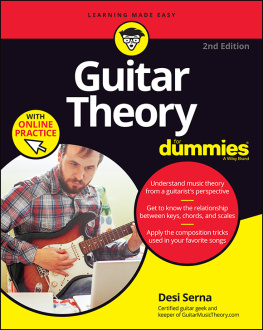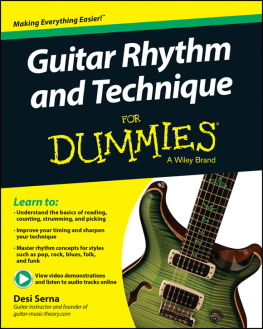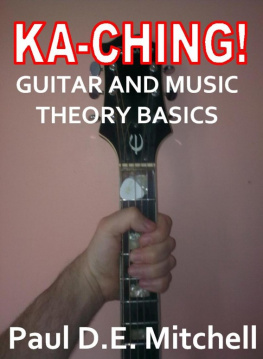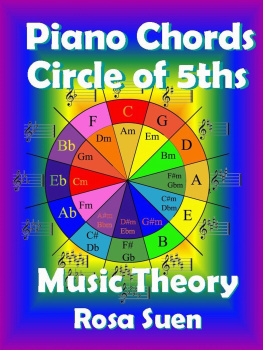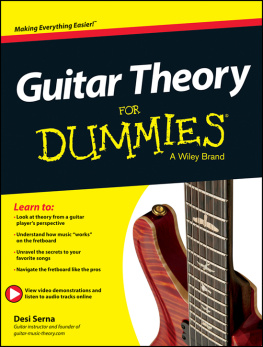

Guitar Theory For Dummies, 2nd Edition with Online Practice
Published by: John Wiley & Sons, Inc., 111 River Street, Hoboken, NJ 07030-5774, www.wiley.com
Copyright 2022 by John Wiley & Sons, Inc., Hoboken, New Jersey
Media and software compilation copyright 2021 by John Wiley & Sons, Inc. All rights reserved.
Published simultaneously in Canada
No part of this publication may be reproduced, stored in a retrieval system or transmitted in any form or by any means, electronic, mechanical, photocopying, recording, scanning or otherwise, except as permitted under Sections 107 or 108 of the 1976 United States Copyright Act, without the prior written permission of the Publisher. Requests to the Publisher for permission should be addressed to the Permissions Department, John Wiley & Sons, Inc., 111 River Street, Hoboken, NJ 07030, (201) 748-6011, fax (201) 748-6008, or online at http://www.wiley.com/go/permissions .
Trademarks: Wiley, For Dummies, the Dummies Man logo, Dummies.com, Making Everything Easier, and related trade dress are trademarks or registered trademarks of John Wiley & Sons, Inc., and may not be used without written permission. All other trademarks are the property of their respective owners. John Wiley & Sons, Inc., is not associated with any product or vendor mentioned in this book.
LIMIT OF LIABILITY/DISCLAIMER OF WARRANTY: WHILE THE PUBLISHER AND AUTHORS HAVE USED THEIR BEST EFFORTS IN PREPARING THIS WORK, THEY MAKE NO REPRESENTATIONS OR WARRANTIES WITH RESPECT TO THE ACCURACY OR COMPLETENESS OF THE CONTENTS OF THIS WORK AND SPECIFICALLY DISCLAIM ALL WARRANTIES, INCLUDING WITHOUT LIMITATION ANY IMPLIED WARRANTIES OF MERCHANTABILITY OR FITNESS FOR A PARTICULAR PURPOSE. NO WARRANTY MAY BE CREATED OR EXTENDED BY SALES REPRESENTATIVES, WRITTEN SALES MATERIALS OR PROMOTIONAL STATEMENTS FOR THIS WORK. THE FACT THAT AN ORGANIZATION, WEBSITE, OR PRODUCT IS REFERRED TO IN THIS WORK AS A CITATION AND/OR POTENTIAL SOURCE OF FURTHER INFORMATION DOES NOT MEAN THAT THE PUBLISHER AND AUTHORS ENDORSE THE INFORMATION OR SERVICES THE ORGANIZATION, WEBSITE, OR PRODUCT MAY PROVIDE OR RECOMMENDATIONS IT MAY MAKE. THIS WORK IS SOLD WITH THE UNDERSTANDING THAT THE PUBLISHER IS NOT ENGAGED IN RENDERING PROFESSIONAL SERVICES. THE ADVICE AND STRATEGIES CONTAINED HEREIN MAY NOT BE SUITABLE FOR YOUR SITUATION. YOU SHOULD CONSULT WITH A SPECIALIST WHERE APPROPRIATE. FURTHER, READERS SHOULD BE AWARE THAT WEBSITES LISTED IN THIS WORK MAY HAVE CHANGED OR DISAPPEARED BETWEEN WHEN THIS WORK WAS WRITTEN AND WHEN IT IS READ. NEITHER THE PUBLISHER NOR AUTHORS SHALL BE LIABLE FOR ANY LOSS OF PROFIT OR ANY OTHER COMMERCIAL DAMAGES, INCLUDING BUT NOT LIMITED TO SPECIAL, INCIDENTAL, CONSEQUENTIAL, OR OTHER DAMAGES.
For general information on our other products and services, please contact our Customer Care Department within the U.S. at 877-762-2974, outside the U.S. at 317-572-3993, or fax 317-572-4002. For technical support, please visit www.wiley.com/techsupport .
Wiley publishes in a variety of print and electronic formats and by print-on-demand. Some material included with standard print versions of this book may not be included in e-books or in print-on-demand. If this book refers to media such as a CD or DVD that is not included in the version you purchased, you may download this material at http://booksupport.wiley.com . For more information about Wiley products, visit www.wiley.com .
Library of Congress Control Number: 2021947193
ISBN 978-1-119-84297-2 (pbk); ISBN 978-1-119-84334-4 (ebk); ISBN 978-1-119-84317-7 (ebk)
Guitar Theory For Dummies
To view this book's Cheat Sheet, simply go to www.dummies.com and search for Guitar Theory For Dummies Cheat Sheet in the Search box.
Table of Contents
List of Tables
- Chapter 6
- Chapter 7
- Chapter 8
- Appendix A
List of Illustrations
- Chapter 1
- Chapter 2
- Chapter 3
- Chapter 4
- Chapter 5
- Chapter 6
- Chapter 7
- Chapter 8
- Chapter 9
- Chapter 10
- Chapter 11
- Chapter 12
- Chapter 13
- Chapter 14
- Chapter 15
- Chapter 16
Guide
Pages
Introduction
Music theory is the study of how music works. Guitar theory focuses on understanding music from a guitar players perspective. Makes sense, right? With a good working knowledge of guitar theory, including the use of scales, chords, progressions, modes, and more, you can figure out why a song is put together the way it is and how you can improvise your own music.
Guitar Theory For Dummies, 2nd Edition with Online Practice focuses on understanding music from a guitar players perspective. The book helps you develop a working knowledge of guitar theory, including the use of scales, chords, progressions, modes, and more. With this knowledge, you can figure out why a song is put together the way it is, and how you can improvise and compose your own music.
This book also covers how to play popular music on the guitar fretboard, as well as why certain elements of music go together the way they do. By popular music, I mean the types of songs you regularly hear on Top 40 and classic rock radio stations, including music by Chuck Berry, The Beatles, Eric Clapton, Led Zeppelin, the Eagles, Guns N Roses, Dave Matthews Band, and U2, just to name a few. Throughout this book, you discover important details of songs like Johnny B. Goode, Purple Haze, Tears in Heaven, Stairway to Heaven, and many more.
Instead of taking a traditional approach to music theory, which usually emphasizes reading and writing standard musical notation, this book takes a hands-on approach that emphasizes playing on the guitar fretboard and using guitar tablature and neck diagrams. For example, it shows you how to play scale patterns used for riffing and jamming guitar music, as well as how to build the same chord shapes on the fretboard that famous guitarists use. It also shows you how to play through common chord progressions that you hear in the most popular radio hits. Perhaps most importantly, though, it explains how all these components work together.
About This Book
Heres what sets this book apart from other guitar resource materials:
- The practicality and efficiency of the content: If you dont need to know a certain topic or technique to play guitar and understand popular music, I dont present it here. On the flip side, I cover many concepts that dont typically show up in traditional music theory courses but that are important for guitar players to learn.
- The number of familiar song references: Say goodbye to learning abstract ideas without knowing how they apply to the music you know and love! I refer to some of the most popular songs and famous guitarists of all time in the pages that follow.
To make the content more accessible, I divided it into five parts:
- , Getting Started with Guitar Theory, explains guitar theory in a nutshell and covers a few things you'll need to know in order to navigate the fretboard throughout the rest of this book.
- , Working with Chords from the Ground Up, describes how chords are formed using triads from the major scale, how to go beyond basic open position chord shapes to play various chord forms based on the CAGED system, and how to create chords with more depth and color using added chord tones and extensions.
Next page
